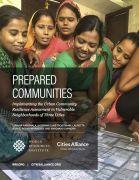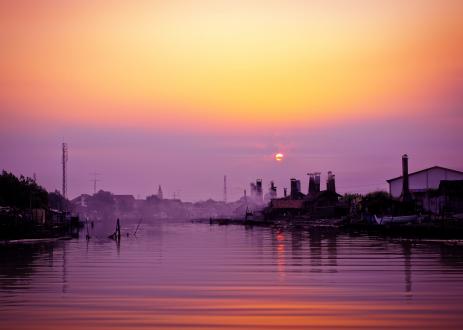Masyarakat yang Siap
Mengimplementasikan Penilaian Ketahanan Masyarakat Urban (UCRA) pada Kawasan Rentan di Tiga Kota

Ringkasan
Perubahan iklim berdampak paling besar pada masyarakat miskin dan marjinal. Sulitnya akses terhadap pelayanan dasar, sejarah panjang pembangunan kota yang tidak berkelanjutan, dan tidak adanya pengakuan hak politik, khususnya di perkotaan, telah membuat masyarakat miskin perkotaan menjadi kelompok yang paling rentan terhadap dampak bencana alam. Namun, strategi untuk meningkatkan ketangguhan mereka seringkali mengabaikan perbedaan kebutuhan dan kondisi yang krusial.
Merespon hal ini, WRI mengembangkan Urban Community Resilience Assement (UCRA), sebuah alat bagi perencana kota untuk mengukur perbedaan kebutuhan untuk ketahanan iklim. Data kota hingga tingkat perumahan yang akurat dan mendalam adalah kunci untuk memastikan respon ketangguhan yang akurat. Mengukur bagaimana masyarakat dan individu merespon potensi risiko iklim bisa membantu mengidentifikasi kebutuhan akan ketahanan dan mengembangkan perencanaan ketahanan kota yang terinformasi. UCRA diuji pada masyarakat berpendapatan rendah dan rentan di tiga kota: Rio de Janeiro, Brasil; Surat, India; dan Semarang, Indonesia. Laporan ini menjelaskan hasil dari uji coba tersebut serta potensi UCRA untuk membangun kota yang lebih tangguh terhadap risiko iklim.
Temuan Utama
Laporan ini untuk sementara hanya tersedia dalam Bahasa Inggris.
Cities can benefit from the UCRA process in several ways. The process helps officials connect resilience actions and policies to vulnerable communities, promotes a culture of inclusive planning, involves multiple stakeholders and participatory activities, and provides cities with a baseline of detailed data at the local level. The city resilience strategy, participatory visioning workshops, and community-level consultations represent a platform for mainstreaming resilience thinking across communities in a city.
Pilot implementation of the UCRA revealed three main limitations. First, a lack of political will and leadership to drive the UCRA process lengthens the implementation period and reduces effectiveness. Second, the UCRA methodology is costly and time-intensive. Third, incongruencies in data, information, and language across the city, neighborhood, and individual levels make it difficult to build consensus among city officials and community members.
The UCRA has the potential to promote peer-to-peer learning between cities. Developing an online community of practice could help promote pro-poor urban climate resilience planning by allowing cities to exchange insights, visually display and share results, and help them overcome barriers to implementation more rapidly.
Ringkasan Utama
Laporan ini untuk sementara hanya tersedia dalam Bahasa Inggris.
Urban resilience is receiving more global attention than ever before. The SDGs and the Paris Agreement make clear commitments to prioritize the lives and well-being of vulnerable communities living in cities. The Urban Community Resilience Assessment tool is well positioned to help cities leverage this international momentum to strengthen social resilience while achieving resilience goals.
This report describes the UCRA and its application in poor communities of Rio de Janeiro, Brazil; Surat, India; and Semarang, Indonesia —three coastal cities that are at increased risk of flooding, landslides, land subsidence, and heat stress. It describes lessons learned and the recommended actions co-developed with community members.
The report is intended for city planners, community-based organizations, and international development organizations interested in enhancing resilience in poor and vulnerable communities. Local development organizations, community leaders, and community rights advocacy groups looking to develop resilience diagnostics and engage in participatory planning with community members may also find it valuable.
The UCRA is a bottom-up resilience planning process that links local knowledge with top-down planning priorities. It is inspired by the place-based approach of Cutter et al. (2008), which focuses on a community’s social resilience potential as well as infrastructural upgrades, early warning and evacuation communication, and trainings to enhance personal resilience capacities.
The UCRA includes 3 dimensions, subdivided into 10 categories and up to 60 indicators. The three dimensions (Figure ES.1) include the vulnerability context at the city level, the community resilience potential of the neighborhood, and household capacities to respond to climate disasters. Within each dimension are flexible indicators that can be customized to the local context.
The UCRA framework allows resilience planners to identify causal relationships across the categories and indicators, leading to resilience actions that can address multiple issues. It provides an opportunity to integrate city-wide vulnerability assessments and resilience strategies with local neighborhood concerns, linking top-down and bottom-up information systems and resilience actions. It aims to use disaster preparedness activities as an entry point for strengthening social networks and building stronger, better-prepared, and more resilient communities.
The UCRA helps cities bring together information on people’s resilience capacities, to connect city-level resilience plans with local residents. It provides cities with a baseline, which allows them to target resilience efforts toward specific gaps in the near term and monitor the impacts of these efforts over the long term. It helps city officials explore causal relationships across different UCRA indicators and enhances overall community and individual resilience by engaging residents in surveys, focus group discussions, and planning workshops. Application of the UCRA can inspire participatory planning in other planning sectors in the city, creating a new culture of inclusionary planning.
The UCRA process is carried out in four phases (Figure ES.2), which took 6–8 months to complete in the three pilot cities. The process allows cities to customize the indicators, identify a team of experts and community leaders who serve as advisors to the implementing team, administer the data collection and analysis, and co-develop resilience actions with community members. Chapter 2 of this report describes the step-wise implementation methodology, based on the team’s experiences in Rio de Janeiro, Surat, and Semarang.
Proyek

Urban Community Resilience Assessment (UCRA)
Kunjungi ProyekMemformulasikan aksi dan kerangka kerja adaptasi yang dapat mengurangi kerentanan dan meningkatkan ketahanan masyarakat kota Semarang dari banjir dan longsor.